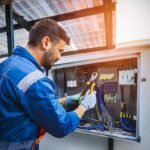As photovoltaic systems age, their performance declines. This is where repowering comes in. So, you will need to modernize your existing system by specifically replacing outdated components such as solar modules or inverters. This significantly increases your solar system’s efficiency and power output without requiring a complete reinstallation. In this guide, learn exactly what repowering means, what advantages it offers, when it’s worthwhile, and what you should consider.

What is repowering in photovoltaics?
Repowering of photovoltaics is the modernization of existing PV systems by replacing outdated components such as solar modules or inverters.
The goal is to improve the system’s yield and efficiency. Older systems, in particular, lose performance over time because of wear and tear, ageing modules, or technical defects. Using modern modules and inverters can significantly increase electricity production in the same area.
Advantages of repowering photovoltaic systems
Solar repowering offers numerous advantages that affect both ecological and economic aspects:
Pros
Disadvantages of solar repowering
While repowering a photovoltaic system offers many advantages, there are also some disadvantages to consider:
Cons
Considering these points will help you decide for or against PV repowering and make an informed, sustainable choice.

When is repowering photovoltaic systems worthwhile?
Repowering photovoltaics is particularly worthwhile when the system has already reached a certain age and is losing efficiency. The decisive factor here is whether the increased performance provided by new components justifies the investment costs. The following factors play a role:
- Age of the system: Solar modules lose performance over time. Repowering often becomes economically viable after 20 to 25 years.
- Condition of the components: Is there a significant drop in yield that cannot be remedied by maintenance or cleaning the modules? Inverters typically last about 15 years. When replacement is due, it’s worth checking the modules as well.
- Suitable opportunity: Is any work planned on the roof or the PV system? For example, has scaffolding been erected that could also be used for repowering?
Requirements for solar repowering
For repowering to be worthwhile, certain requirements must be met:
- Compatibility of new components: New modules or inverters must be compatible with existing technology to ensure smooth installation. For example, can the inverter handle the additional power?
- Format / size of the modules: Can the new modules be installed on the existing substructure?
- Can existing scaffolding be used?
- Cost-benefit analysis: The investment costs should pay for themselves within a reasonable period of time. A professional assessment by a specialist company can help here.
What should be considered when repowering?
Repowering only makes economic sense if the expected additional yields outweigh the necessary investments. From a purely ecological perspective, modernizing a PV system is always worthwhile.
For cost reasons, it’s often not practical to replace all modules unless their performance is already very low to begin with. A complete replacement can cost as much as a new installation, especially if the modules have different formats and the existing substructure can no longer be used.
Partial replacement of modules
However, partially replacing modules brings with it several disadvantages: The new module cannot exploit its advantages when combined with the old ones, because the system output—more precisely, that of the respective string—is always determined by the module with the lowest output. So, it is pointless to directly connect old and new modules.
This problem can be solved by connecting all new and all old modules in a single string and feeding the strings into the inverter as two subsystems. However, the inverter must also have at least two inputs with corresponding MPP trackers to extract optimal performance from the PV system.
When selecting modules to replace, it would also be wise to identify those with the lowest performance. However, this is generally not worthwhile, as this would require measuring the performance of each individual module, e.g., by flashing. Alternatively, individual modules can be bypassed on the roof and the energy management system can determine the impact on yield.
While identifying low-performing modules is desirable for sustainability reasons, it is unlikely to be implemented in practice because of the effort and costs involved. Also, removing individual low-performing modules requires repositioning the remaining modules. This requires significant installation effort and associated costs.
Strand-wise exchange
If the system already consists of several strings, the ones with the lowest performance can simply be replaced. Here, too, the prerequisite is that the corresponding string performance can be measured. This is easily possible using an energy management system.
Once you have identified the lower-performing string, replace the corresponding modules. Repowering the sub-system involves manageable effort and costs, allowing the investment to pay for itself over the long term.
Other posts you may be interested in
Solar repowering vs. maintenance and cleaning
Before repowering, check whether simple maintenance or cleaning measures already have the desired effect. Dirt or defective cables often lead to performance losses, which can be easily remedied with little organizational and financial effort. Repowering, on the other hand, aims to achieve long-term performance improvements through the replacement of components and is significantly more expensive. However, if repowering significantly increases yield, it can be worthwhile.

Conclusion
Repowering as a worthwhile investment
Repowering is a sensible measure for maximizing the yields of older photovoltaic systems. Thanks to technological advances, this can be an attractive option for continuing to operate older systems. Individual consultation with a specialist company is essential for optimally exploiting the potential of modernization and reaping long-term economic benefits.






Leave a Reply